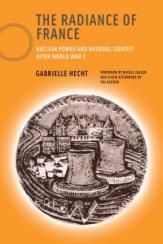 Today, it is scarcely possible to imagine what France might look like without a nuclear industry. Reactors, uranium mines, plutonium reprocessing plants and atomic research centers permeate the landscape and provide over 75% of the nation’s electricity. The enormous state-owned conglomerate Areva has become the world’s largest manufacturer and exporter of nuclear systems. In the 1940s, however, such outcomes were unimaginable. The Radiance of France: Nuclear Power and National Identity after World War II offers a historical account of how French territory, industry, and identity became entwined with nuclear technology from the 1950s to the early 1970s. It examines how conflicts over reactor design became forms of political debate and decision-making, a process Hecht calls technopolitics. In designing and operating nuclear power plants, experts and workers proposed a range of prescriptions for French society and politics. Radiance explores how the resulting technopolitical arrangements and ambiguities produced and enacted power relationships among experts, between experts and workers, and between reactor sites and communities. By the early 1970s, it argues, contests over the terms of a technologically-inflected national identity had reshaped the state, its military, labor unions, and rural communities in fundamental ways.
Today, it is scarcely possible to imagine what France might look like without a nuclear industry. Reactors, uranium mines, plutonium reprocessing plants and atomic research centers permeate the landscape and provide over 75% of the nation’s electricity. The enormous state-owned conglomerate Areva has become the world’s largest manufacturer and exporter of nuclear systems. In the 1940s, however, such outcomes were unimaginable. The Radiance of France: Nuclear Power and National Identity after World War II offers a historical account of how French territory, industry, and identity became entwined with nuclear technology from the 1950s to the early 1970s. It examines how conflicts over reactor design became forms of political debate and decision-making, a process Hecht calls technopolitics. In designing and operating nuclear power plants, experts and workers proposed a range of prescriptions for French society and politics. Radiance explores how the resulting technopolitical arrangements and ambiguities produced and enacted power relationships among experts, between experts and workers, and between reactor sites and communities. By the early 1970s, it argues, contests over the terms of a technologically-inflected national identity had reshaped the state, its military, labor unions, and rural communities in fundamental ways.
Radiance of France: Introduction & Preface by Michel Callon
Chapter 2: Technopolitical Regimes. Shows how France’s first reactors were designed to optimize weapons-grade plutonium production in order to launch a nuclear weapons program before state leaders made an official decision.
Chapter 8: Warring Systems. Describes the process by which French leaders decided to abandon their gas-graphite design in favor of a pressurized water reactor license purchased from Westinghouse. The conflict involved not only political and technical elites, but also labor unions, workers, and communities. This file also includes the book’s conclusion, and the Afterword to the 2009 edition.
awards
Henry Baxter Adams Prize in European history, American Historical Association, 1999
Edelstein Prize, Society for the History of Technology, 2001
Runner-up, Fleck Prize, Society for the Social Studies of Science, 2000
en français
Le rayonnement de la France: Énergie nucléaire et identité nationale après la seconde guerre mondiale.
- première édition: Éditions de la Découverte, Collection Anthropologie des Sciences et Techniques, 2004
- deuxième édition: Éditions Amsterdam, 2014
One thought on “The Radiance of France (1998; 2nd edition 2009)”
Comments are closed.